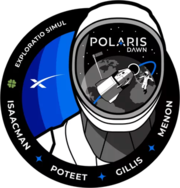Polaris Dawn
 | |
| Mission type | Private spaceflight |
|---|---|
| Operator | SpaceX |
| Website | polarisprogram.com/dawn |
| Mission duration | 5 days |
| Spacecraft properties | |
| Spacecraft | Crew Dragon Resilience |
| Spacecraft type | Crew Dragon |
| Crew | |
| Crew size | 4 |
| Members | Jared Isaacman Scott Poteet Sarah Gillis Anna Menon |
| Start of mission | |
| Launch date | March 2023 (planned)[1] |
| Rocket | Falcon 9 Block 5 |
| Launch site | Kennedy Space Center, LC-39A |
| Contractor | SpaceX |
| Orbital parameters | |
| Periapsis altitude | 190 km (120 mi) |
| Apoapsis altitude | 1,400 km (870 mi) (initially) 750 km (470 mi) (later)[2] |
 Mission Patch  Isaacman, Poteet, Gillis, and Menon | |
Polaris Dawn is a planned private human spaceflight mission, operated by SpaceX on behalf of Shift4 Payments CEO Jared Isaacman,[3][4] scheduled to launch no earlier than March 2023.[1] The flight will be using the Crew Dragon capsule, and is the first of three planned missions in a program named the Polaris program.[5] It is planned to be the ninth crewed flight overall of the Crew Dragon.
Crew
| Position | Astronaut | |
|---|---|---|
| Mission Commander | Second spaceflight | |
| Mission Pilot | First spaceflight | |
| Mission Specialist 1 | First spaceflight | |
| Mission Specialist 2 & Medical Officer | First spaceflight | |
Mission
Polaris Dawn will be a human spaceflight to orbit Earth with only private citizens on board. The crew will consist of Jared Isaacman, Scott Poteet, Sarah Gillis, and Anna Menon, who will spend up to five days in orbit. Mission plans include reaching an orbit higher than any previous Dragon mission and ultimately the highest Earth orbit ever flown by a crewed spacecraft with an initial apogee of 1400 km,[2] breaking the record set by Gemini 11.[6] The crew will conduct 38 science and research experiments to study the effects of spaceflight and space radiation on human health.[7] The crew will also attempt the first commercial extravehicular activity (EVA) with SpaceX-designed EVA spacesuits.[8] The mission will also be the first test of Starlink's communications laser for communication with another spacecraft, potentially improving connection with the spacecraft.[9]
See also
References
- ^ a b "Polaris Dawn". Polaris Program. Retrieved 20 September 2022.
- ^ a b "Scott Poteet Discusses Inspiration4 and Polaris Dawn Missions (Part 2)". May 9, 2022. Retrieved May 10, 2022.
- ^ Clark, Stephen (14 February 2022). "Billionaire plans three more flights with SpaceX, culminating in Starship mission". Spaceflight Now. Retrieved 14 February 2022.
- ^ "Jared Isaacman, who led the first all-private astronaut mission to orbit, has commissioned 3 more flights from SpaceX". The Washington Post. ISSN 0190-8286. Retrieved 2022-02-14.
- ^ Sheetz, Michael (2022-02-14). "Billionaire astronaut Jared Isaacman buys more private SpaceX flights, including one on Starship". CNBC. Retrieved 2022-02-18.
- ^ Sibu Kumar Tripathi (2022-02-15). "What is Polaris Dawn mission announced by SpaceX that launches Musk's astronaut corps?". India Today. Retrieved 2022-02-18.
- ^ "Polaris Dawn Selects 38 Science and Research Experiments to Advance Human Health and Space Exploration". Polaris Dawn (Press release). PR Newswire. 24 October 2022. Retrieved 24 October 2022.
- ^ Howell, Elizabeth (2022-02-14). "Meet the four private Polaris Dawn astronauts SpaceX will launch into orbit this year". Space.com. Retrieved 2022-02-18.
- ^ "Starlink expanding, coming to Dragon capsule on Polaris Dawn, but NASA has concerns about the constellation". Space Explored. 2022-02-17. Retrieved 2022-02-18.



